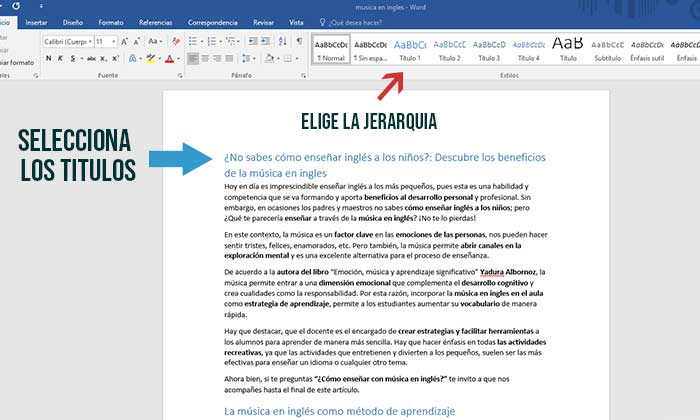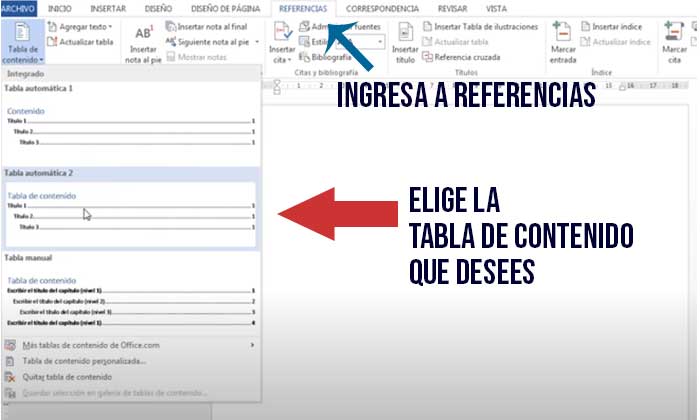
After so long since the first time Microsoft showed the world his office suite "Microsoft Office", continues to be one of the most used programs, with essential functions and new features every year. That is why in this guide we are going to teach you how to take advantage of a very useful function, stay to learn how to make an index in word.
In the same way as in web pages, this function will help you to better order in your document, allowing you to organize it by chapters and that you can find a specific part easily. Without further ado, let's get started!
How to make an automatic index in Word?
However, this option is not presented in a explicit, which is why it is often overlooked and is not in common use. What you should do to create your index is the next:
- Go to the tab "Beginning" on the toolbar Word.
- In section "Styles" you will find "Title 1", click on it and write the name you want that section of the document to have.
- Note: If you want there to be subsections within the main section, use the rest of the styles "Title 2", "Title 3" Y "Title 4", etc.

- Go to the document sheet where you want the index, go to the option "References" in the toolbar and position yourself on the first option "Table of Contents".
- In this section, click on the option "Table of Contents", this will display a ready with different designs to choose your index.

- In addition to the predefined designs, you can create your own by selecting the option "Custom table of contents ...".
- Note: This option can give your document a specific order and more originality if you want.
Delete or update the index
Since we learned how to make an index in wordLet's see some tools that this function has. If you have added new tickets to your document and you want to delete or update the list, you must do the following:
- To remove: Select the entry field in the index and press the key. suppress.
- To actualize: Go to option "Table of Contents" and press "Update Table".
How to number the titles?
In order to maintain a better order in the structure, you can organize your titles as follows:
- Select the titles you want number.
- Go to the tab "Beginning" in the toolbar, in the section "Paragraph", select the checkbox "Multilevel list".
- Here it will show the different options you have for the list, choose the one you like the most.
- Update the index as we showed you previously and that's it.
What is an index in Word?
If we compare an index of a book with one in Word, we can conclude that these fulfill the same function. The goal of an index is list the topics or chapters that a document contains, generally, including the number of the page where it is located.
Hence, it is often used in papers, projects and theses, making it easier for the reader to access to content of your interest.
In any case, to go to the desired section, just go to the index and click while pressing the Ctrl key; immediately, it will show you what is related to the title you pressed.
Index structure
Of course, the index will have the appearance and functions of the template we have chosen. However, you may be features do not comply with the ones we need, that is why the application allows us modify them. The main characteristics that we can modify are:
- Qualification: The default table of contents title is "Content". When you select it, you can change the name and its Format (font, size, style, etc.)
- Format: This decision is merely esthetic, allowing you to choose the font, the color and the way of numbering.
- Space between title and page number: In the option of "Custom Table of Contents", you can choose which character will be between the spaces. Generally used points and the scripts.

Recommendations when making your table of contents
Without a doubt, if you want to make a good index, there are a few things you should keep in mind. If you are interested, we mention some of them:
- Choose good names for the sections: If you are not presenting an official job and you have to select the names yourself, think of something original, that adequately describes the contents to be discussed in that section.
- Create your own template: Word provides us with a series of options so that we can accommodate the index in the desired way, take advantage of these tools to the maximum to make your work stand out.
- Define the titles and subtitles well: As we already mentioned, you can include Subtitle within the main title. Think carefully about the importance of the content and how they are related, in this way, you will get a better structure in the document.
Advantages of tables of contents
The reason for using an index in your document beyond the organization, is to take advantage of the various advantage that this offers you. Since we learned how to make an index in word, let's see what you can get thanks to this:
- Better text structure: Being forced to do a index, you will realize that there is content that covers more than another, being able to identify them and granting them the value what they deserve.
- Ease of finding content: Rarely does anyone read the entire documents, so when you make a table of contents, you do more accessible find what someone is looking for.
- Attractive to the eye: The Format is one of the essential pillars to make attractive visually to your documents; for this reason, make your index look good, it is very important if you want get the reader's attention.
- Tool Mastery: Have dominion over Microsoft Office is an essential quality for endless jobs, if you learn to use this type of tools, you will have greater job possibilities and a new ability in your everyday life.
Conclution
To finish, let's hope that our guide “how to make an index in word”Has been helpful. If you are interested in more content about Office, you might be interested to know how to activate Office 2016 permanently. Keep browsing our website, where you will find more articles and related guides. Thank you very much for reading, see you soon!